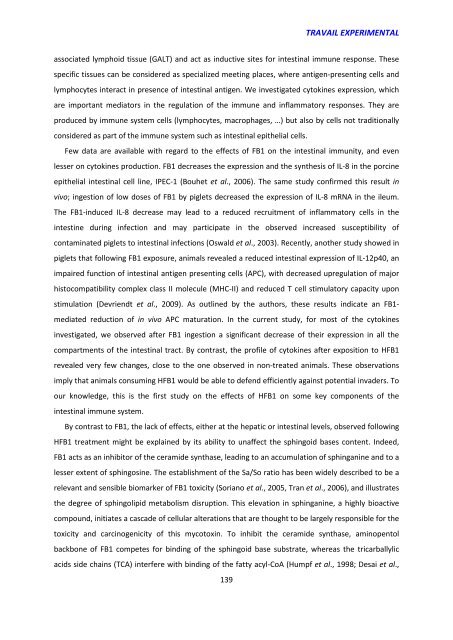Effet chez le porcelet d'une exposition à un régime co-contaminé en ...
Effet chez le porcelet d'une exposition à un régime co-contaminé en ...
Effet chez le porcelet d'une exposition à un régime co-contaminé en ...
Create successful ePaper yourself
Turn your PDF publications into a flip-book with our unique Google optimized e-Paper software.
TRAVAIL EXPERIMENTALassociated lymphoid tissue (GALT) and act as inductive sites for intestinal imm<strong>un</strong>e response. Thesespecific tissues can be <strong>co</strong>nsidered as specialized meeting places, where antig<strong>en</strong>-pres<strong>en</strong>ting cells andlymphocytes interact in pres<strong>en</strong>ce of intestinal antig<strong>en</strong>. We investigated cytokines expression, whichare important mediators in the regulation of the imm<strong>un</strong>e and inflammatory responses. They areproduced by imm<strong>un</strong>e system cells (lymphocytes, macrophages, …) but also by cells not traditionally<strong>co</strong>nsidered as part of the imm<strong>un</strong>e system such as intestinal epithelial cells.Few data are availab<strong>le</strong> with regard to the effects of FB1 on the intestinal imm<strong>un</strong>ity, and ev<strong>en</strong><strong>le</strong>sser on cytokines production. FB1 decreases the expression and the synthesis of IL-8 in the porcineepithelial intestinal cell line, IPEC-1 (Bouhet et al., 2006). The same study <strong>co</strong>nfirmed this result invivo; ingestion of low doses of FB1 by pig<strong>le</strong>ts decreased the expression of IL-8 mRNA in the i<strong>le</strong>um.The FB1-induced IL-8 decrease may <strong>le</strong>ad to a reduced recruitm<strong>en</strong>t of inflammatory cells in theintestine during infection and may participate in the observed increased susceptibility of<strong>co</strong>ntaminated pig<strong>le</strong>ts to intestinal infections (Oswald et al., 2003). Rec<strong>en</strong>tly, another study showed inpig<strong>le</strong>ts that following FB1 exposure, animals revea<strong>le</strong>d a reduced intestinal expression of IL-12p40, animpaired f<strong>un</strong>ction of intestinal antig<strong>en</strong> pres<strong>en</strong>ting cells (APC), with decreased upregulation of majorhisto<strong>co</strong>mpatibility <strong>co</strong>mp<strong>le</strong>x class II mo<strong>le</strong>cu<strong>le</strong> (MHC-II) and reduced T cell stimulatory capacity uponstimulation (Devri<strong>en</strong>dt et al., 2009). As outlined by the authors, these results indicate an FB1-mediated reduction of in vivo APC maturation. In the curr<strong>en</strong>t study, for most of the cytokinesinvestigated, we observed after FB1 ingestion a significant decrease of their expression in all the<strong>co</strong>mpartm<strong>en</strong>ts of the intestinal tract. By <strong>co</strong>ntrast, the profi<strong>le</strong> of cytokines after <strong>exposition</strong> to HFB1revea<strong>le</strong>d very few changes, close to the one observed in non-treated animals. These observationsimply that animals <strong>co</strong>nsuming HFB1 would be ab<strong>le</strong> to def<strong>en</strong>d effici<strong>en</strong>tly against pot<strong>en</strong>tial invaders. Toour know<strong>le</strong>dge, this is the first study on the effects of HFB1 on some key <strong>co</strong>mpon<strong>en</strong>ts of theintestinal imm<strong>un</strong>e system.By <strong>co</strong>ntrast to FB1, the lack of effects, either at the hepatic or intestinal <strong>le</strong>vels, observed followingHFB1 treatm<strong>en</strong>t might be explained by its ability to <strong>un</strong>affect the sphingoid bases <strong>co</strong>nt<strong>en</strong>t. Indeed,FB1 acts as an inhibitor of the ceramide synthase, <strong>le</strong>ading to an accumulation of sphinganine and to a<strong>le</strong>sser ext<strong>en</strong>t of sphingosine. The establishm<strong>en</strong>t of the Sa/So ratio has be<strong>en</strong> widely described to be are<strong>le</strong>vant and s<strong>en</strong>sib<strong>le</strong> biomarker of FB1 toxicity (Soriano et al., 2005, Tran et al., 2006), and illustratesthe degree of sphingolipid metabolism disruption. This e<strong>le</strong>vation in sphinganine, a highly bioactive<strong>co</strong>mpo<strong>un</strong>d, initiates a cascade of cellular alterations that are thought to be largely responsib<strong>le</strong> for thetoxicity and carcinog<strong>en</strong>icity of this my<strong>co</strong>toxin. To inhibit the ceramide synthase, aminop<strong>en</strong>tolbackbone of FB1 <strong>co</strong>mpetes for binding of the sphingoid base substrate, whereas the tricarballylicacids side chains (TCA) interfere with binding of the fatty acyl-CoA (Humpf et al., 1998; Desai et al.,139

















